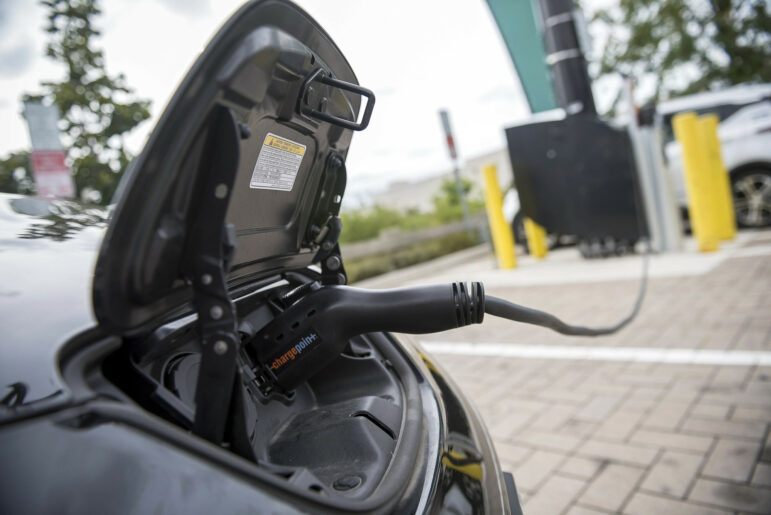Of the 1.9 million registered vehicles in the city, 2 percent are electric. While that may seem nominal, electric vehicle registrations are growing: there was a 44 percent increase between 2021 and 2022, according to the city’s Department of Transportation.

Ed Reed/Mayoral Photography Office
An electric vehicle charging at a station in Brooklyn.New York is being recognized for its leading role in the electric vehicle revolution.
The Empire State ranked number two on the recently released American Council for an Energy-Efficient Economy’s electrification scorecard, which evaluates states based on how well their policies encourage electric vehicle (EV) adoption.
California, which boasts over 550,000 electric vehicle registrations, took first place, scoring 88 out of 100 points compared to New York which scored 62 points. This is the second year in a row that New York has claimed the number two spot.
The scorecard applauded New York’s efforts to incentivize the purchase of EVs and EV charging infrastructure, incorporate equity considerations into its planning—the state dedicated 16 percent of utility EV spending to underserved communities— and effectively integrate EV infrastructure into the electrical grid.
The report also touted New York’s commitment to electrifying its school bus fleet. The state currently boasts 489 zero emission buses overall and has committed to making 100 percent of new school buses zero-emissions by 2027.
Still, there is room for improvement.
“Given the importance of public transportation in the state, New York should set a binding target for all transit agencies to transition to electric transit buses,” said Peter Huether, the report’s author.
Transportation is responsible for about 30 percent of New York City’s greenhouse gas emissions, the second leading source after buildings. Burning gasoline releases pollutants into the air that can exacerbate health conditions like asthma. In California, which is leading the electric vehicle revolution, the introduction of zero-emissions vehicles has already led to healthier outcomes.
All eyes will be on New York in the coming years to see if it can expand its electric vehicle infrastructure in a way that’s safe and equitable and make good on its ambitious renewable energy promises.
What’s been done so far
New York State, through legislative action, has made adopting electric vehicles a top priority.
In 2022, Gov. Hochul—following California’s lead—announced that New York will require all new passenger cars, pickup trucks, and SUVs sold in the state to be zero emissions by 2035.
The MTA, which runs the largest public bus system in the country, plans to transition its entire fleet of 5,800 buses to battery-powered electric vehicles by 2040.
Legislators at the city level are also focused on ramping up the use of electric vehicles.
At a June 23 Committee on Transportation and Infrastructure hearing, representatives from the Department of Transportation (DOT) and the Department of City Administrative Services (DCAS) testified about the city’s efforts to expand EV infrastructure across the five boroughs.
According to DOT, of the 1.9 million registered vehicles in the city, 2 percent are electric. While that may seem nominal, EV registrations are growing: there was a 44 percent increase between 2021 and 2022.
DCAS, which has been tasked with electrifying the city’s vehicle fleet, shared that they are on track to exceed 5,000 EVs by the end of the year.
Concerns about safety and equity
As DOT and DCAS work to expand the city’s electric vehicle footprint, councilmembers are intent on making sure they do so in a safe, equitable, and accessible manner.
At the June 23 hearing, Councilmember Selvena N. Brooks-Powers, who chairs the Committee on Transportation and Infrastructure, asked DOT and DCAS how they will ensure that the charging stations are distributed equitably throughout the five boroughs. The majority are currently concentrated in Manhattan and inner Brooklyn and Queens.
William Carey, assistant commissioner for policy at DOT, responded by saying that the department is focusing its investments in areas where the private market isn’t, like the Rockaways in Queens.
“Equity is at the core of this administration’s priorities and certainly my commissioner’s priorities,” he said.
In PlaNYC: Getting Sustainability Done, the mayor promised that all New Yorkers will live within 2.5 miles of EV charging stations by 2035. As of now, only 65 percent have this access.
According to Carey, about half of the vehicles in New York City rely on curbside parking and lack access to private chargers. This means the city will need to prioritize expanding its current collection of publicly accessible chargers.
Safety was also top of mind at the hearing. Certain EVs on the market are quite hefty: for example, the GMC Hummer EV clocks in at 9,000 pounds. With this in mind, Brooks-Powers wanted to know how the city plans to protect pedestrians and the city’s aging infrastructure.
“Although there are profound benefits to the adoption of EVs, there are safety concerns particularly revolving around the additional weight of EVs,” she said.
In response, Carey emphasized tightening speed limits: “Speed management, including our 25 mile an hour speed limit, is our best tool as it reduces the harm in crashes at all weight classes,” he said.
On the accessibility front, Councilmember Amanda Farías introduced a bill that would create a surcharge to fund the expansion of wheelchair accessible and all-electric for-hire vehicles.
Uber and Lyft will be required to go electric by 2030, per a commitment Mayor Adams made in his State of the City speech in January.
All of these considerations are being made with the city and state’s renewable energy goals in mind. As outlined in PlaNYC: Getting Sustainability Done, New York City aims to have EVs constitute 20 percent of new vehicle registrations by 2050.
“For the sake of our air quality, the health and wellness of New Yorkers, and the growing threat of climate change, it is imperative we do everything in our power to decarbonize our transportation system by 2050,” said Councilmember Farías.








